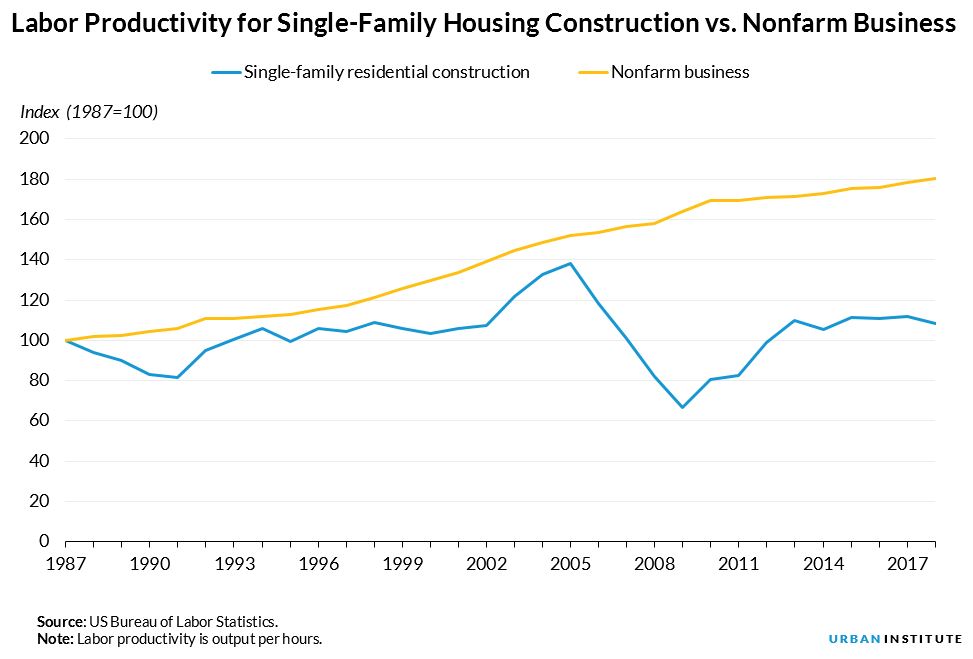
<p>Photo by Dan Reynolds Photography via Getty Images.</p>
The home building industry remains reliant on the traditional, site-built construction process that was in place at the beginning of the 20th century. Technology has advanced this process, but site-built construction is still less efficient and costlier than off-site construction.
Experts gathered at the Urban Institute’s recent symposium, Reimagining Housing: Closing the Equity and Supply Gaps, to discuss the benefits of off-site construction and three challenges facing its increased use in the US.

Off-site construction offers many advantages
Gerry McCaughey, CEO of the off-site construction company Entekra, explained the benefits of off-site home building with an analogy to car buying: you wouldn’t want a car dealership to ship your new car in parts to your driveway and have workers come by your house for weeks to put it together.
Off-site construction uses industrial-size machines that can quickly replicate home parts, reducing the need for labor, an important benefit amid concerns over the cost and availability of labor and relatively lower productivity across the residential construction industry.

Some evidence shows that the off-site model increases efficiency and reduces the costs of building homes. Entekra compared its factory process building prefabricated (or “kit”) homes with the stick-built method and found a three-fold increase in labor productivity. The Manufactured Housing Institute has estimated that the price to build a manufactured home is less than half the cost to build a site-built home: $50 versus $111 per square foot. The lack of substantial improvements in labor availability and productivity in single-family home construction has contributed to higher-than-expected price points on new homes.
Three barriers to off-site construction in the US
In Sweden, 90 percent (PDF) of single-family homes are built off site, but off-site construction has never taken hold in the US.
Economist Lynn Fisher explained that although experiments with off-site housing have historically come in cycles (PDF), they have never successfully replaced the site-built template. As many as 250,000 prefab homes, such as those popularized by Sears, were sold during the 1940s but have since disappeared.
In 2018, off-site construction made up the smallest share of single-family housing construction it has comprised since 1992. Manufactured housing, or the more stigmatized mobile home, made up around 50 percent of all new single-family home production in the 1960s and ’70s but has fallen to as low as 10 percent. The prospect for future investment in off-site construction will be constrained by uncertainty over the future of the US economy.
The panelists discussed three significant barriers to off-site construction in the US today:
1. Fluctuating demand
The initial capital needed to start off-site production, such as a factory and software, require large upfront investments that are less profitable if the economy is in the latter stages of the business cycle. Alternatively, by taking on upfront construction costs on a house-by-house basis and subcontracting for labor, conventional site-builders can weather cyclical downturns.
Diversification is one potential solution to the challenges presented by building cycles. By expanding the products beyond the single-family market to also include commercial and multifamily construction, off-site builders could hedge their exposure to fluctuations in single-family construction.
Another solution could be to separate the home builder from the off-site producer in a way that allows the off-site company to sufficiently connect to different markets with a variety of builders.
2. Consumer preferences
Consumers continue to show a strong preference for site-built homes, particularly compared with manufactured housing.
Manufactured homes have been stigmatized for being cheaply built, despite significant recent improvements in quality. And the preference for prefab housing has been historically dampened by consumer’s desire for maximum design flexibility.
Surveys by the Manufactured Housing Institute reveal an increased interest in newer manufactured home styles that include design features such as porches and pitched roofs. These survey results also indicate that manufactured housing demand is relatively higher within immigrant and other communities who have been historically restricted from homeownership.
Prefabricated homes have also grown in popularity partly because they now offer a wider range of customization.
3. Restrictive zoning and expensive financing
Financing for nontraditional homes is a barrier to the growth in off-site building. In manufactured housing, chattel loans dominate the lending market. Chattel loans are more costly than mortgages and finance the physical home but not the land. Households with chattel loans own the structure but miss out on land appreciation.
Chattel loans dominate the manufactured housing lending market for two reasons:
- Confusion: People don’t understand the title issues involved.
- Convenience: Chattel is the default loan type on the title in most states and chattel lenders are available at most manufactured home sale sites.
Local zoning rules often explicitly ban manufactured homes, and local building codes present a real challenge to factory-built housing because it’s challenging to offer housing that meets the standards in hundreds of local jurisdictions.
The blueprint for addressing these problems has been developed. According to Jonathan Lawless, vice president of product development and affordable housing at Fannie Mae, Fannie Mae’s MH Advantage program provides an accessible alternative financing mechanism to the chattel loan as part of their “duty to serve” commitment.
The Department of Housing and Urban Development’s manufactured housing code preempts local building codes and could be extended to other types of off-site building.
Boosting the affordable housing stock is a key challenge of our time. Although not a complete solution, off-site building can help us address the current affordable housing crisis by improving efficiency and overcoming the labor shortage, but policymakers and industry leaders need to work together to better understand and address the current barriers to increased use.
Let’s build a future where everyone, everywhere has the opportunity and power to thrive
Urban is more determined than ever to partner with changemakers to unlock opportunities that give people across the country a fair shot at reaching their fullest potential. Invest in Urban to power this type of work.